Alcatel 980A, 981A, OT-981A, OT-980A Instruction Manual
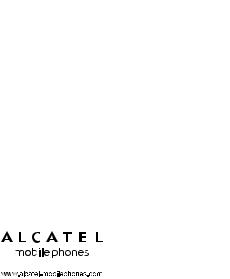
2
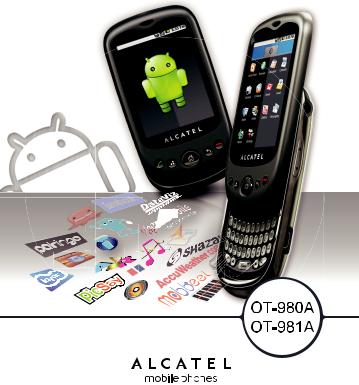
3
Table of Contents
Safety and use...................................................................... |
4 |
||
General information ........................................................... |
9 |
||
1 |
Your cellphone................................................................... |
12 |
|
|
1.1 |
Keys and connectors................................................................................ |
12 |
|
1.2 |
Getting started .......................................................................................... |
14 |
|
1.3 |
Home screen.............................................................................................. |
18 |
2 |
Text input........................................................................... |
27 |
|
|
2.1 |
Using Hardware Keyboard...................................................................... |
27 |
|
2.2 |
Using Onscreen Keyboard...................................................................... |
28 |
|
2.3 |
Text editing ................................................................................................. |
28 |
3 |
phone call, Call log and Contacts.................................... |
29 |
|
|
3.1 |
Phone ........................................................................................................... |
29 |
|
3.2 |
Call log......................................................................................................... |
33 |
|
3.3 |
Contacts...................................................................................................... |
34 |
4 |
Google Messaging, Gmail/Email, GoogleTalk and GoogleVoice.... |
42 |
|
|
4.1 |
Google Messaging ..................................................................................... |
42 |
|
4.2 |
Gmail/Email................................................................................................. |
47 |
|
4.3 |
Google Talk ................................................................................................. |
52 |
5 |
Google Calendar & Alarm clock & Calculator .............. |
56 |
|
|
5.1 |
Google Calendar ....................................................................................... |
56 |
|
5.2 |
Alarm Clock ............................................................................................... |
58 |
|
5.3 |
Calculator.................................................................................................... |
59 |
6 |
Getting connected ............................................................ |
61 |
|
|
6.1 |
Connecting to the Internet .................................................................... |
61 |
|
6.2 |
Browser ....................................................................................................... |
64 |
|
6.3 |
Connecting to Bluetooth devices.......................................................... |
72 |
|
6.4 |
Connecting to a computer via USB...................................................... |
73 |
|
6.5 |
Connecting to virtual private networks .............................................. |
75 |
1
7 Android Market................................................................. |
77 |
|
7.1 |
Locate the item you want to download and install.......................... |
77 |
7.2 |
Download and install................................................................................ |
78 |
7.3 |
Manage your downloads.......................................................................... |
80 |
8 Multimedia applications ................................................... |
82 |
|
8.1 |
Camera/Camcorder/ ................................................................................ |
82 |
8.2 |
Gallery ......................................................................................................... |
85 |
8.3 |
YouTube....................................................................................................... |
87 |
8.4 |
Music ............................................................................................................ |
88 |
9 Google Maps...................................................................... |
91 |
|
9.1 |
Get My Location ....................................................................................... |
91 |
9.2 |
Search for a location ................................................................................ |
92 |
9.3 |
Star a location............................................................................................ |
93 |
9.4 |
Get driving, public transport or walking directions.......................... |
94 |
9.5 |
Arrangement of Layers ............................................................................ |
96 |
9.6 |
Join Latitude to see your friends' locations and share yours with them...... |
97 |
10 Others .............................................................................. |
101 |
|
10.1 |
FileManager............................................................................................... |
101 |
10.2 |
Notes ......................................................................................................... |
102 |
10.3 |
TaskManager ............................................................................................. |
102 |
10.4 |
Videos ........................................................................................................ |
102 |
10.5 |
Voice Recorder........................................................................................ |
102 |
10.6 |
SyncMLClient ........................................................................................... |
104 |
10.7 |
TSCalibration ........................................................................................... |
104 |
10.8 |
Other applications .................................................................................. |
105 |
11 Settings ............................................................................ |
106 |
|
11.1 |
Wireless & networks ............................................................................. |
106 |
11.2 |
Call settings .............................................................................................. |
108 |
11.3 |
Sound & display........................................................................................ |
110 |
11.4 |
Location & security................................................................................. |
112 |
2
|
11.5 |
Applications .............................................................................................. |
114 |
|
11.6 |
Accounts & sync...................................................................................... |
116 |
|
11.7 |
Privacy........................................................................................................ |
118 |
|
11.8 |
SD card, USB Mass Storage & phone storage.................................. |
119 |
|
11.9 |
Search......................................................................................................... |
120 |
|
11.10 |
Language & keyboard ............................................................................. |
121 |
|
11.11 |
Accessibility ............................................................................................. |
122 |
|
11.12 |
Text-to-speech ......................................................................................... |
123 |
|
11.13 |
Date & time.............................................................................................. |
124 |
|
11.14 |
About cellphone...................................................................................... |
125 |
12 |
Making the most of your cellphone .............................. |
126 |
|
|
12.1 |
PC suite ..................................................................................................... |
126 |
13 |
Alcatel Mobile Phones Limited Warranty .................... |
127 |
|
14 |
Accessories ..................................................................... |
129 |
|
15 |
Troubleshooting .............................................................. |
130 |
|
16 |
Specifications................................................................... |
134 |
|
3
Safety and use..............................
We recommend that you read this chapter carefully before using your cellphone. The manufacturer disclaims any liability for damage, which may result as a consequence of improper use or use contrary to the instructions contained herein.
• TRAFFIC SAFETY:
Given that studies show that using a cellphone while driving a vehicle constitutes a real risk, even when the hands-free kit is used (car kit, headset...), drivers are requested to refrain from using their cellphone when the vehicle is not parked. Check the laws and regulations on the use of wireless telephones and their accessories in the areas where you drive. Always obey them. The use of these devices may be prohibited or restricted in certain areas.
When driving, do not use your cellphone and headphone to listen to music or to the radio. Using a headphone can be dangerous and forbidden in some areas.
When switched on, your cellphone emits electromagnetic waves that can interfere with the vehicle’s electronic systems such as ABS anti-lock brakes or airbags. To ensure that there is no problem:
When switched on, your cellphone emits electromagnetic waves that can interfere with the vehicle’s electronic systems such as ABS anti-lock brakes or airbags. To ensure that there is no problem:
-do not place your cellphone on top of the dashboard or within an airbag deployment area,
-check with your car dealer or the car manufacturer to make sure that the car’s electronic devices are shielded from cellphone RF energy..
• CONDITIONS OF USE:
You are advised to switch off the cellphone from time to time to optimize its performance. Remember to abide by local authority rules of cellphone use on aircrafts.
Switch the cellphone off when you are in health care facilities, except in designated areas. As with many other types of equipment now in regular use, cellphones can interfere with other electrical or electronic devices, or equipment using radio frequency.
Switch the cellphone off when you are near gas or flammable liquids. Strictly obey all signs and instructions posted in a fuel depot, gas station, or chemical plant, or in any potentially explosive atmosphere.
When the cellphone is switched on, it should be kept at least 15 cm from any medical device such as a pacemaker, a hearing aid or insulin pump. In particular when using the cellphone you should hold it against the ear on the opposite side to the device, if any.
To avoid hearing impairment, answer the call before holding your cellphone to your ear. Also move the handset away from your ear while using the “hands-free” option because the amplified volume might cause hearing damage.
It is recommended to have proper supervision while small children use your cellphone.
When replacing the cover please note that your cellphone may contain substances that could create an allergic reaction.
Always handle your cellphone with care and keep it in a clean and dust-free place.
4

Do not allow your cellphone to be exposed to adverse weather or environmental conditions (moisture, humidity, rain, infiltration of liquids, dust, sea air, etc.). The manufacturer’s recommended operating temperature range is -10°C to +55°C (the max value depends on device, materials and housing paint/texture).
Over 55°C the legibility of the cellphone’s display may be impaired, though this is temporary and not serious.
Do not open or attempt to repair your cellphone yourself. Do not drop, throw or try to bend your cellphone.
Do not paint it.
Use only batteries, battery chargers, and accessories which are recommended by TCT Mobile Limited and its affiliates and are compatible with your cellphone model.TCT Mobile Limited and its affiliates disclaim any liability for damage caused by the use of other chargers or batteries.
Your cellphone should not be disposed of in a municipal waste. Please check local regulations for disposal of electronic products.
Remember to make back-up copies or keep a written record of all important information stored in your cellphone.
Some people may suffer epileptic seizures or blackouts when exposed to flashing lights, or when playing video games. These seizures or blackouts may occur even if a person never had a previous seizure or blackout. If you have experienced seizures or blackouts, or if you have a family history of such occurrences, please consult your doctor before playing video games on your cellphone or enabling a flashing-lights feature on your cellphone. Parents should monitor their children’s use of video games or other features that incorporate flashing lights on the cellphones. All persons should discontinue use and consult a doctor if any of the following symptoms occur: convulsion, eye or muscle twitching, loss of awareness, involuntary movements, or disorientation. To limit the likelihood of such symptoms, please take the following safety precautions:
- Play at the farthest distance possible from the screen.
When you play games on your cellphone, you may experience occasional discomfort in your hands, arms, shoulders, neck, or other parts of your body. Follow these instructions to avoid problems such as tendinitis, carpal tunnel syndrome, or other musculoskeletal disorders:
-Take a minimum of a 15-minute break every hour of game playing.
-If your hands, wrists, or arms become tired or sore while playing, stop and rest for several hours before playing again.
-If you continue to have sore hands, wrists, or arms during or after playing, stop the game and see a doctor.
Prolonged exposure to music at full volume using the music player may damage your hearing. Set your cellphone’s volume to it’s lowest setting prior to inserting headphones in your ears and adjust the volume to your preference. Only use headphones that are recommended by TCT Mobile Limited and it’s affiliates.
5

• PRIVACY:
Please note that you must respect the laws and regulations in force in your jurisdiction or other jurisdiction(s) where you will use your cellphone regarding taking photographs and recording sounds with your cellphone. Pursuant to such laws and regulations, it may be strictly forbidden to take photographs and/or to record the voices of other people or any of their personal attributes, and reproduce or distribute them, as this may be considered to be an invasion of privacy.
It is the user’s sole responsibility to ensure that prior authorization be obtained, if necessary, in order to record private or confidential conversations or take a photograph of another person; the manufacturer, the seller or vendor of your cellphone (including the operator) disclaim any liability which may result from the improper use of the cellphone.
• BATTERY AND ACCESSORIES:
Before removing the battery from your cellphone, please make sure that the cellphone is switched off. Observe the following precautions for battery use:
-Do not attempt to open the battery (due to the risk of toxic fumes and burns).
-Do not puncture, disassemble or cause a short-circuit in a battery,
-Do not burn or dispose of a used battery in the garbage or store it at temperatures above 60°C. Batteries must be disposed of in accordance with locally applicable environmental regulations. Only use the battery for the purpose for which it was designed. Never use damaged batteries or those not recommended by TCT Mobile Limited and/or its affiliates.
This symbol on your cellphone, the battery and the accessories means that these products must be taken to collection points at the end of their life:
- Municipal waste disposal centers with specific bins for these items of equipment - Collection bins at points of sale.
They will then be recycled, preventing substances being disposed of in the environment, so that their components can be reused.
In European Union countries:
These collection points are accessible free of charge. All products with this sign must be brought to these collection points.
In non European Union jurisdictions:
Items of equipment with this symbol are not be thrown into ordinary bins if your jurisdiction or your region has suitable recycling and collection facilities; instead they are to be taken to collection points for them to be recycled.
In the United States you may learn more about CTIA’s Recycling Program at www. recyclewirelessphones.com
CAUTION: RISK OF EXPLOSION IF BATTERY IS REPLACED BY AN INCORRECT TYPE. DISPOSE OF USED BATTERIES ACCORDING TO THE INSTRUCTIONS
• CHARGERS
Home A.C./ Travel chargers will operate within the temperature range of: 0°C to 40°C.
The chargers designed for your cellphone meet with the standard for safety of information technology equipment and office equipment use. Due to different applicable electrical specifications, a charger you purchased in one jurisdiction may not work in another jurisdiction. They should be
used for this purpose only.
Characteristics of power supply (depending on the country):
6
Travel charger: Input: 100-240 V, 50/60 Hz, 0.15 A
Output: 5 V, 500 mA
Battery: |
Lithium 1150 mAh |
• RADIO WAVES:
THIS CELLPHONE MEETS THE GOVERNMENT’S REQUIREMENTS FOR EXPOSURE TO RADIO WAVES.
Your cellphone is a radio transmitter and receiver. It is designed and manufactured not to exceed the emission limits for exposure to radio-frequency (RF) energy. These limits are part of comprehensive guidelines and establish permitted levels of RF energy for the general population. The guidelines are based on standards that were developed by independent scientific organizations through periodic and thorough evaluation of scientific studies. These guidelines include a substantial safety margin designed to ensure the safety of all persons, regardless of age and health.
The exposure standard for cellphones employs a unit of measurement known as the Specific Absorption Rate, or SAR. The SAR limit set by public authorities such as the Federal Communications Commission of the US Government (FCC), or by Industry Canada, is 1.6 W/kg averaged over 1 gram of body tissue. Tests for SAR are conducted using standard operating positions with the cellphone transmitting at its highest certified power level in all tested frequency bands.
Although the SAR is determined at the highest certified power level, the actual SAR level of the cellphone while operating can be well below the maximum value. This is because the cellphone is designed to operate at multiple power levels so as to use only the power required to reach the network. In general, the closer you are to a wireless base station antenna, the lower the power output of the cellphone Before a cellphone model is available for sale to the public, compliance with national regulations and standards must be shown.
The highest SAR value for this model cellphone when tested is 0.883 W/Kg (OT-980A), 0.701 W/ Kg (OT-981A) for use at the ear and 1.11 W/Kg (OT-980A), 1.16 W/Kg (OT-981A) for use close to the body.
While there may be differences between the SAR levels of various cellphones and at various positions, they all meet the government requirement for RF exposure. For body-worn operation, the cellphone meets FCC RF exposure guidelines provided that it is used with a non-metallic accessory with the handset at least 1.5 cm from the body. Use of other accessories may not ensure compliance with FCC RF exposure guidelines.
The World Health Organization (WHO) considers that present scientific information does not indicate the need for any special precautions for use of cellphones. If individuals are concerned, they might choose to limit their own or their children’s RF exposure by limiting the length of calls, or using “hands-free” devices to keep cellphones away from the head and body. (fact sheet n°193). Additional WHO information about electromagnetic fields and public health are available on the following website: http://www.who.int/peh-emf.
Note: This equipment has been tested and found to comply with the limits for a Class B digital device pursuant to part 15 of the FCC Rules. These limits are designed to provide reasonable protection against harmful interference in a residential installation. This equipment generates, uses and can radiate radio frequency energy and, if not installed and used in accordance with the instructions, may cause harmful interference to radio communications. However, there is no guarantee that interference to radio or television reception, which can be determined by turning the equipment off and on, the user is encouraged to try to correct the interference by one or more of the following measures:
-Reorient or relocate the receiving antenna.
-Increase the separation between the equipment and receiver.
7

-Connect the equipment into an outlet on a circuit different from that to which the receiver is connected.
-Consult the dealer or an experienced radio/ TV technician for help.
Changes or modifications not expressly approved by the party responsible for compliance could void the user’s authority to operate the equipment.
For the receiver devices associated with the operation of a licensed radio service (e.g. FM broadcast), they bear the following statement:
This device complies with Part 15 of the FCC Rules. Operation is subject to the condition that this device does not cause harmful interference.
For other devices, they bear the following statement:
This device complies with Part 15 of the FCC Rules. Operation is subject to the following two conditions:
(1)this device may not cause harmful interference
(2)this device must accept any interference received, including interference that may cause undesired operation.
Your cellphone is equipped with a built-in antenna. For optimal operation, you should avoid touching it or degrading it.
As cellphone devices offer a range of functions, they can be used in positions other than against your ear. In such circumstances the device will be compliant with the guidelines when used with headset or usb data cable. If you are using another accessory ensure that whatever product is used is free
of any metal and that it positions the cellphone at least 2cm away from the body.
• LICENCES
microSD Logo is a trademark.
The Bluetooth word mark and logos are owned by the Bluetooth SIG, Inc. and any use of such marks by TCT Mobile Limited and its affiliates is under license. Other trademarks and trade names are those of their respective owners.
OT-980A/OT-981ABluetoothQDIDB016877
The Wi-Fi Logo is a certification mark of the Wi-Fi Alliance.
Google, the Google logo,Android, the Android logo, Google Search TM, Google MapsTM, Gmail TM,YouTube,Android Market, Google Latitude TM and Google Talk TM are trademarks of Google Inc.
Hearing Aid Compatibility
Your cellphone is rated: "For Hearing Aid", to assist hearing device users in finding phones that may be compatible with their hearing devices.
This device is HAC M3 compatible.
For more information please refer to "Hearing Aid Compatibility with Mobile Phones" leaflet or visit our website http://www.alcatel-mobilephones.com/
8
General information ...................
•Website: www.alcatel-mobilephones.com
•Hot Line Number: In the United States, call 877-702-3444 for technical support.
On our Internet site, you will find our FAQ (Frequently Asked Questions) section. You can also contact us by e-mail to ask any questions you may have.
An electronic version of this user guide is available in English and other languages according to availability on our server: www.alcatelmobilephones.com
Your cellphone is a transceiver that operates on following networks:
OT-980A: GSM/GPRS/EDGE networks in quad-band (850/900/1800/1900 MHz) UMTS in dual-band (850/1900 MHz)
OT-981A: GSM/GPRS/EDGE networks in quad-band (850/900/1800/1900 MHz) UMTS in dual-band (1700/2100 MHz)
Protection against theft (1)
Your cellphone is identified by an IMEI (cellphone serial number) shown on the packaging label and in the product’s memory. We recommend that you note the number the first time you use your cellphone by entering *#06# and keep it in a safe place. It may be requested by the police or your operator if your cellphone is stolen.
(1)Contact your network operator to check service availability.
9
Disclaimer
There may be certain differences between the user manual description and the cellphone’s operation, depending on the software release of your cellphone or specific operator services.
TCT Mobile shall not be held legally responsible for such differences, if any, nor for their potential consequences, which responsibility shall be borne by the operator exclusively.
10
This handset may contain materials, including applications and software in executable or source code form, which is submitted by third parties for inclusion in this handset (“Third Party Materials”). All third party materials in this handset are provided “as is”, without warranty of any kind, whether express or implied, including the implied warranties of merchantability, fitness for a particular purpose or use/third party application, interoperability with other materials or applications of the purchaser and non-infringement of copyright. The purchaser undertakes that TCT Mobile has complied with all quality obligations incumbent upon it as a manufacturer of mobile devices and handsets in complying with Intellectual Property rights. TCT Mobile will at no stage be responsible for the inability or failure of the Third Party Materials to operate on this handset or in interaction with any other devices of the purchaser. To the maximum extent permitted by law, TCT Mobile disclaims all liability for any claims, demands, suits or actions, and more specifically – but not limited to – tort law actions, under any theory of liability, arising out of the use, by whatever means, or attempts to use, such Third Party Materials. Moreover, the present Third Party Materials, which are provided free of charge by TCT Mobile, may be subject to paid updates and upgrades in the future;TCT Mobile waives any responsibility regarding such additional costs, which shall be borne exclusively by the purchaser.The availability of the applications may vary depending on the countries and the operators where the handset is used; in no event shall the list of possible applications and software provided with the handsets be considered as an undertaking from TCT Mobile; it shall remain merely as information for the purchaser. Therefore, TCT Mobile shall not be held responsible for the lack of availability of one or more applications wished for by the purchaser, as its availability depends on the country and the operator of the purchaser. TCT mobile reserves the right at any time to add or remove Third Party Materials from its handsets without prior notice; in no event shall TCT Mobile be held responsible by the purchaser for any consequences that such removal may have on the purchaser regarding the use or attempt to use such applications and Third Party Materials.
11
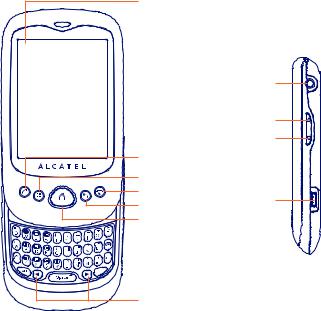
1 Your cellphone ......................
1.1Keys and connectors
Touchscreen
|
Headset connector |
|
|
Volume up |
|
|
Volume down |
|
Call key |
|
|
Menu key |
|
|
End key |
Micro-USB connector |
|
Back key |
||
|
||
Home key |
|

 Search key
Search key
Left/Right navigation keys
12

 /
/
ALT+  /
/
• Answer/Send a call
• Enter Call Log
• Return to current call screen if the user navigates to other applications during call.
• On Home screen, press to quickly access Settings menu or Notification panel; to launch quick search; to customize your Home screen by adding applications or changing wallpaper.
• On other screens, press to view options list.
Short press: Return to the Home screen or back to the central Home screen if it is extended.
Long press: Enter the recently used applications list. Go back to the previous menu or screen.
Short press: End a call
Lock the screen
Long press: When cellphone is off, power on the cellphone. When cellphone is on, enter Phone options: Silent mode, Airplane mode, Power off.
Press to adjust the Volume (in call/media playing mode)
Open Search bar for searching within an application, the cellphone or web.
Press to go left/right
Press to go up/down
13
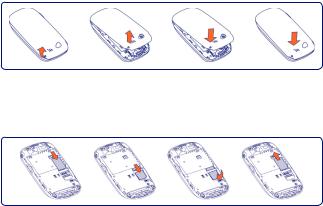
1.2Getting started
1.2.1 Set-up
Removing or installing the back cover
Inserting or removing the SIM card (1)
You must insert your SIM card to make phone calls. Please power off your cellphone and remove battery before inserting or removing the SIM card.
Place the SIM card with the chip facing downwards and slide it into its housing. Make sure that it is correctly inserted.To remove the card, press and slide it out.
(1)Check with your network operator to make sure that your SIM card is 3V or 1.8V compatible.The old 5 volt cards can no longer be used.
14
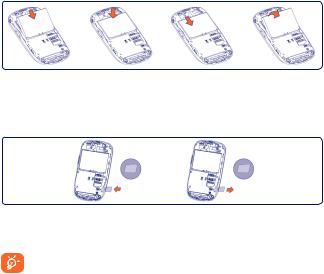
Installing or removing the battery
• Insert and click the battery into place, then close the cellphone cover.
• Unclip the cover, then remove the battery.
Installing and removing the memory card (MicroSD card)
Insert the MicroSD card with golden contact facing downwards into the slot until it is locked. Gently push the memory card until it is unlocked.
To remove the microSD card while the cellphone is on, you must unmount the storage card from the cellphone first, to prevent corrupting or damaging the storage card.
15

Charging the battery
Standard charger
UK charger
Connect the battery charger.
•Charging may take about 20 minutes to start if the battery is dead.
•Be careful not to force the plug into the socket.
•Make sure the battery is correctly inserted before connecting the charger.
•The mains socket must be near to the cellphone and easily accessible (avoid electric extension cables).
•When using your cellphone for the first time, charge the battery fully (approximately 3 hours).
You are advised to fully charge the battery ( ).
).
Charging is complete when the animation stops  .
.
16

1.2.2 Power on your cellphone
Hold down the End key until the cellphone powers on, type in your PIN code if necessary and then confirm.The Home screen is displayed.
If you do not know your PIN code or if you have forgotten it, contact your network operator. Do not leave your PIN code with your cellphone. Store this information in a safe place when not in use.
Set up your cellphone for the first time
The first time you power on the cellphone, you are required to touch the Android logo to begin and then sign into your Google Account to synchronize email, contacts, calendar and other Google applications (1).
•Enter your user name and password, then touch Sign in. If you forget your password, you can go to http://www.google.com/ to retrieve it. If you don’t own a Google Account, you are prompted to create one by touching Create.
•Read the setup information on the screen, then touch Next.
•Set up the date and time, then touch Next.
•Touch Finish setup.
In power on screen without SIM card inserted, you can also connect to a Wi-Fi network (refer to section 6.1.2 Wi-Fi) to sign into your Google Account and to use some features.
(1)Application availability depends on country and operator.
17
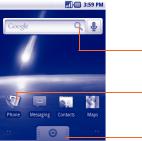
1.2.3 Power off your cellphone
Hold down the End key from the Home screen until the cellphone options appear, select Power off.
1.3Home screen
You can bring all the items (applications, shortcuts, folders and widgets) you love or use most frequently to your Home screen for quick access. Press Home key to switch to Home screen.
|
|
Status bar |
|
|
|
||
|
|
• Status/Notification indicators |
|
n |
o |
• Touch and Drag down to open notification |
|
panel. |
|||
|
|
Search bar
Touch n to enter text search screen.
Touch o to enter voice search screen.
Touch an icon to open an application, folder, etc.
Application tab
Touch or Drag up to open application list.
Home screen is provided in an extended format to allow more space for adding applications, shortcuts etc. Slide the Home screen horizontally left and right to get a complete view of the Home screen. Small dots at the lower left and right of the screen indicate which screen you are viewing.
18
1.3.1 Using the touchscreen
Touch
To access an application, touch it with your finger.
Touch and Hold
To enter the available options for an item, touch and hold the item. For example, select a contact in Directory, touch and hold this contact, an option list will then appear on screen.
Drag
Place your finger on the screen to drag an object to another location.
Slide/Swipe
Slide the screen to scroll up and down the applications, images, web pages… at your convenience.
Flick
Similar to swiping, but flicking makes it move quicker.
Rotate
Automatically change the screen orientation from portrait to landscape by turning the cellphone sideways to have a better screen view.
1.3.2 Status bar
From status bar, you can view both cellphone status (to the right side) and notification information (to the left side).When the status bar is full, “ ” icon will appear, touch to display hidden icons.
” icon will appear, touch to display hidden icons.
19
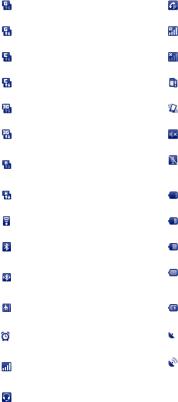
Status icons
|
GPRS connected |
|
Speakerphone is on |
|
|
|
|
|
GPRS in use |
|
Roaming |
|
|
|
|
|
EDGE connected |
|
No signal |
|
|
|
|
|
EDGE in use |
|
No SIM card installed |
|
|
|
|
|
3G connected |
|
Vibrate mode |
|
|
|
|
|
3G in use |
|
Ringer is silenced |
|
|
|
|
|
HSPA (3G+) connected |
|
Cellphone microphone is |
|
|
mute |
|
|
|
|
|
|
|
|
|
|
HSPA (3G+) in use |
|
Battery is very low |
|
|
|
|
|
Connected to a Wi-Fi network |
|
Battery is low |
|
|
|
|
|
Bluetooth is on |
|
Battery is partially drained |
|
|
|
|
|
Connected to a Bluetooth |
|
Battery is full |
|
device |
|
|
|
|
|
|
|
|
|
|
|
Airplane mode |
|
Battery is charging |
|
|
|
|
|
Alarm is set |
|
GPS is on |
|
|
|
|
|
Signal strength |
|
Receiving location data from |
|
|
GPS |
|
|
|
|
|
|
|
|
|
|
Headset connected |
|
|
|
|
|
|
20

Notification icons
|
New Gmail message |
|
More notifications are |
|
|
hidden |
|
|
|
|
|
|
|
|
|
|
New text or multimedia |
|
Call in progress (green) |
|
message |
|
|
|
|
|
|
|
|
|
|
|
Problem with text or |
|
Call in progress using |
|
multimedia message delivery |
|
Bluetooth headset (blue) |
|
|
|
|
|
New Google Talk message |
|
Missed call |
|
|
|
|
|
New voicemail |
|
Call on hold |
|
|
|
|
|
Upcoming event |
|
Call forwarding is on |
|
|
|
|
|
Data is synchronizing |
|
Uploading data |
|
|
|
|
|
Problem with sign-in or |
|
Downloading data |
|
synchronization |
|
|
|
|
|
|
|
|
|
|
|
microSD card is full |
|
Download finished |
|
|
|
|
|
An open Wi-Fi network is |
|
Connected to VPN |
|
available |
|
|
|
|
|
|
|
|
|
|
|
Cellphone is connected via |
|
Disconnected from VPN |
|
USB cable |
|
|
|
|
|
|
|
|
|
|
|
Song is playing |
|
System update available |
|
|
|
|
21
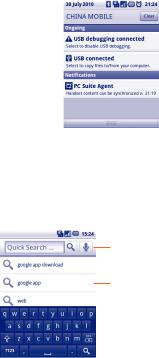
Notification panel
Touch and drag down the Status bar or press Menu key and touch Notifications to open the notification panel.Touch and drag up to close it. From Notification panel, you can open items and other reminders indicated by notification icons or view wireless service information.
Touch  to clear all event–based notifications (other ongoing notifications will remain).
to clear all event–based notifications (other ongoing notifications will remain).
1.3.3 Search bar
The cellphone provides a Search function which can be used to locate information within applications, the cellphone or the web.
Touch to search by voice
 Touch to search by text
Touch to search by text
Search shortcuts history
22

Search by text
•Touch  from Home screen or press Search key from other applications screen.
from Home screen or press Search key from other applications screen.
•Enter the text/phrase you want to search for.
•Touch  .
.
Search by voice
•Touch  from Search bar to display a dialog screen.
from Search bar to display a dialog screen.
•Speak the word/phrase you want to search for. A list of search results will display for you to select from.
1.3.4 Lock/Unlock your screen
To protect your cellphone and privacy, you can lock the cellphone screen by creating a variety of patterns.
To create a screen unlock pattern (refer to section11.4.2 for detailed settings)
•Press Menu key from the home screen, touch Settings, then touch
Location & Security\Screen unlock pattern.
•Draw your own pattern, you can also press Menu key for help.
Draw your unlock pattern
Touch to confirm by drawing pattern again
23
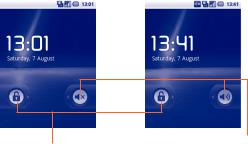
To lock cellphone screen
Press End key once to lock the screen.
To unlock cellphone screen
Draw the unlock pattern you have created to wake up the screen. If you did not set the unlock screen, drag the green lock icon to the right to unlock it.
Drag to the right to unlock the screen
Drag to the left to activate silent mode or normal mode
1.3.5 Personalize your home screen
Add
Touch and hold an empty area or press Menu key and touch Add on the Home screen.The Add to Home screen will appear, offering a range of options.
24
• Shortcuts |
To add a shortcut to Home screen, such as |
|
applications, bookmark, contact, etc. |
• Widgets |
To add a widget to Home screen, such as clock, |
|
music player, etc. |
• Folders |
To add a folder to Home screen, such as new |
|
folder, contact folder, etc. |
To improve the organization of the Home screen items (shortcuts, widgets), you can add them to a folder by touching and dragging them onto the folder of your choice.To rename a folder, open it, touch and hold the folder’s title bar to open the Rename folder dialog box, then enter the new folder name and confirm with OK.
Reposition
Touch and hold the item to be repositioned to activate the Move mode, drag the item to the desired position and then release. Hold the icon on the left or right edge of the screen to drag the item to another Home screen page.
Remove
Touch and hold the item to be removed to activate the Move mode, drag the item to the top of the Application tab, which will then turn red, and release.
Wallpaper customization
Touch and hold an empty area or press Menu key and touch Wallpaper on the Home screen, a popup window named Select wallpaper from will appear, offering a range of options. Pictures includes pictures you have taken, cropped or downloaded. Wallpaper gallery includes all preset wallpapers in the cellphone. Slide left and right to locate a desired image, touch Set wallpaper to confirm.
25

1.3.6 Application tab
Touch or drag up the  on Home screen to enter applications list.
on Home screen to enter applications list.
To close it, touch or drag it down.
Consult recently-used applications
To consult recently-used applications, you can press and hold the Home key from Home screen.Touch an icon in the window to open the related application.
1.3.7 Volume adjustment
Using volume key
Press Volume up/down key to adjust the volume. While in the lowest volume level (Silent mode), press Volume down key once, your cellphone will now be switched to Vibration mode. Press Volume up key once in Vibration mode and it will change to silent mode.
Using Settings menu
Press Menu key from Home screen, then touch Settings\Sound & display, you can set ringer, media and cellphone ringtone volume to your preference.
Besides the above two ways, you can also switch between silent mode and normal mode easily, refer to section 1.3.4.
26
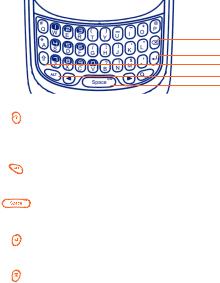
2 Text input ..............................
Your cellphone is equipped with two kinds of keyboard: Hardware Keyboard and Onscreen Keyboard.
2.1Using Hardware Keyboard
Slide up the cellphone to open the Hardware Keyboard.
Delete key
Enter key
Shift key
ALT key
Space key
Press once: Input a capitalized character
Shift+Space: to select input method
Press twice: Lock the keyboard in capital letter input mode Press once: Input a top-half character
Press twice: Lock the keyboard in top-half key input mode Enter a space
ALT+Space: to enter symbol table
Confirm an option
Enter the next line
Delete a word or character
27

2.2Using Onscreen Keyboard
Onscreen keyboard will display automatically when a program requires entering text or numbers.
Touch to enter text or numbers, touch and hold to select input method.
Touch to lock in capital letter input mode.
Touch to switch to symbol and numeric keyboard.
Onscreen keyboard settings
Press Menu key from Home screen, select Settings\Language & Keyboard settings\Android keyboard, a series of settings are available for your selection.
Adjust the onscreen keyboard orientation
Turn the cellphone sideways or upright to adjust the onscreen keyboard orientation.You can also adjust it by settings (Press Menu key on Home screen\Settings\Sound & display).
2.3Text editing
You can edit the text you have entered.
•Touch and hold text you have entered
•An option list pops up
•Select the operation you need (Select all, Select text, Cut all, Copy all, etc.)
28
